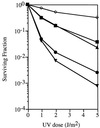A thermostable single-strand DNase from Methanococcus jannaschii related to the RecJ recombination and repair exonuclease from Escherichia coli
- PMID: 10633092
- PMCID: PMC94321
- DOI: 10.1128/JB.182.3.607-612.2000
A thermostable single-strand DNase from Methanococcus jannaschii related to the RecJ recombination and repair exonuclease from Escherichia coli
Abstract
The RecJ protein of Escherichia coli plays an important role in a number of DNA repair and recombination pathways. RecJ catalyzes processive degradation of single-stranded DNA in a 5'-to-3' direction. Sequences highly related to those encoding RecJ can be found in most of the eubacterial genomes sequenced to date. From alignment of these sequences, seven conserved motifs are apparent. At least five of these motifs are shared among a large family of proteins in eubacteria, eukaryotes, and archaea, including the PPX1 polyphosphatase of yeast and Drosophila Prune. Archaeal genomes are particularly rich in such sequences, but it has not been clear whether any of the encoded proteins play a functional role similar to that of RecJ exonuclease. We have investigated three such proteins from Methanococcus jannaschii with the strongest overall sequence similarity to E. coli RecJ. Two of the genes, MJ0977 and MJ0831, partially complement a recJ mutant phenotype in E. coli. The expression of MJ0977 in E. coli resulted in high levels of a thermostable single-stranded DNase activity with properties similar to those of RecJ exonuclease. Despite overall weak sequence similarity between the MJ0977 product and RecJ, these nucleases are likely to have similar biological functions.
Figures





Similar articles
-
Mutational analysis of the RecJ exonuclease of Escherichia coli: identification of phosphoesterase motifs.J Bacteriol. 1999 Oct;181(19):6098-102. doi: 10.1128/JB.181.19.6098-6102.1999. J Bacteriol. 1999. PMID: 10498723 Free PMC article.
-
Single-strand DNA-specific exonucleases in Escherichia coli. Roles in repair and mutation avoidance.Genetics. 1998 May;149(1):7-16. doi: 10.1093/genetics/149.1.7. Genetics. 1998. PMID: 9584082 Free PMC article.
-
Release of 5'-terminal deoxyribose-phosphate residues from incised abasic sites in DNA by the Escherichia coli RecJ protein.Nucleic Acids Res. 1994 Mar 25;22(6):993-8. doi: 10.1093/nar/22.6.993. Nucleic Acids Res. 1994. PMID: 7512263 Free PMC article.
-
Exonuclease requirements for recombination of lambda-phage in recD mutants of Escherichia coli.Genetics. 2006 Aug;173(4):2399-402. doi: 10.1534/genetics.106.060426. Epub 2006 May 15. Genetics. 2006. PMID: 16702415 Free PMC article. Review.
-
Homologous pairing proteins encoded by the Escherichia coli recE and recT genes.Mol Microbiol. 1994 Jan;11(1):23-30. doi: 10.1111/j.1365-2958.1994.tb00286.x. Mol Microbiol. 1994. PMID: 8145642 Review.
Cited by
-
RecJ-like protein from Pyrococcus furiosus has 3'-5' exonuclease activity on RNA: implications for proofreading of 3'-mismatched RNA primers in DNA replication.Nucleic Acids Res. 2013 Jun;41(11):5817-26. doi: 10.1093/nar/gkt275. Epub 2013 Apr 19. Nucleic Acids Res. 2013. PMID: 23605041 Free PMC article.
-
Possible function of the second RecJ-like protein in stalled replication fork repair by interacting with Hef.Sci Rep. 2017 Dec 5;7(1):16949. doi: 10.1038/s41598-017-17306-0. Sci Rep. 2017. PMID: 29209094 Free PMC article.
-
Structure of RecJ exonuclease defines its specificity for single-stranded DNA.J Biol Chem. 2010 Mar 26;285(13):9762-9769. doi: 10.1074/jbc.M109.096487. Epub 2010 Feb 2. J Biol Chem. 2010. PMID: 20129927 Free PMC article.
-
A Novel C-Terminal Domain of RecJ is Critical for Interaction with HerA in Deinococcus radiodurans.Front Microbiol. 2015 Nov 30;6:1302. doi: 10.3389/fmicb.2015.01302. eCollection 2015. Front Microbiol. 2015. PMID: 26648913 Free PMC article.
-
Two Archaeal RecJ Nucleases from Methanocaldococcus jannaschii Show Reverse Hydrolysis Polarity: Implication to Their Unique Function in Archaea.Genes (Basel). 2017 Aug 24;8(9):211. doi: 10.3390/genes8090211. Genes (Basel). 2017. PMID: 28837073 Free PMC article.
References
-
- Aravind L, Koonin E V. A novel family of predicted phosphoesterases includes Drosophila Prune protein and bacterial RecJ exonuclease. Trends Biochem Sci. 1998;23:17–19. - PubMed
-
- Bradford M M. A rapid and sensitive method for the quantitation of microgram quantities of protein utilizing the principle of protein-dye binding. Anal Biochem. 1976;72:248–254. - PubMed
Publication types
MeSH terms
Substances
Grants and funding
LinkOut - more resources
Full Text Sources

